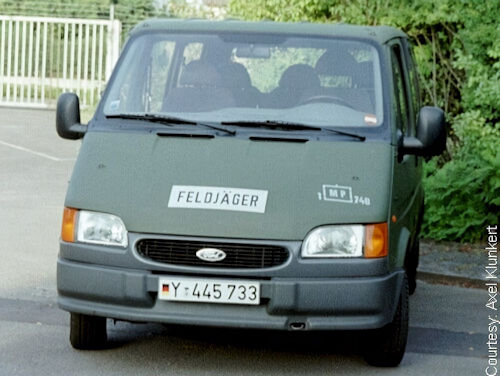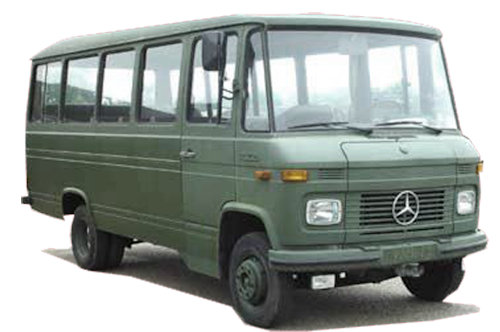Generally, the vehicles for mixed use present in the armed forces are the most exploited and have traveled many more kilometers. Whether they are in the car, bus or truck version, it is their dimensions that have made them preferable in barracks services and non-operational journeys, also for cost reasons. A logic that focuses on the importance of how to invest the few resources for the means and the role of the military motorization, today more than ever called to make "optimizations".
Fiat Ducato
Since 1981 it has been the most popular multitasking commercial vehicle par excellence that has also depopulated in the barracks after having replaced the less fortunate Fiat 242. A true chameleon on a par with the more robust big brother Iveco Daily from which the values of capacity, traction and a more automotive setting, albeit devoted to work, essentially separate it.
During the many restylings, including engine restylings, which took place during its five generations, the load-bearing and modular body and the front-wheel drive made it possible to optimize the loading area even more, making the Fiat Ducato a vehicle of global interest and use.
The twin Citroën series are added jumper and Peugeot Boxer and the Dodge RAM Pro Master 1500 for North American markets.
In the barracks
 In the military field it has always played the role of vehicle (commonly defined as a van) for mixed use, but it is the many set-ups that give it specific roles even at the border of operations, especially after the introduction of four-wheel drive with the second series.
In the military field it has always played the role of vehicle (commonly defined as a van) for mixed use, but it is the many set-ups that give it specific roles even at the border of operations, especially after the introduction of four-wheel drive with the second series.
Those who worked in the military in the 80s will remember it in the bus version as well as in its basic conformation of "van" or dumpster for the minute maintenance rather than a mobile or anti-riot office for the Fo
Engines and mechanics aside, the initial quality of Fiat Duchy born during the economic boom of the time, it was not the best although the investment in design was commendable; the use of plastic materials for the interiors was not the best and echoed those of contemporary Fiat Rhythm. In the first series the gear lever placed on the steering column was quite inaccurate and it was not difficult for it to remain in your hands, while the rubberiness of the gearbox, later positioned on the dashboard, improved with the makeover.
Although the revolutionary study on the ergonomics of the driver's seat was perceived as a rather unknown aspect in commercial automotive, the switches, locks, lighting and seats did not do justice to the noble vehicle that someone associated with a hyper-vitaminized Fiat Uno. . Excellent automotive qualities, the brilliance of petrol engines, while diesel engines had to wait for the introduction of supercharging.
 Ford Transit
Ford Transit
In the Bundesheer he is the oldest Ford Transit born in '53 to be Fiat's most direct competitor Duchy, who in the year of his debut had to compete also commercially with a German rival already in the third generation.
Il Transit it took up the concept of a Europeanized Van USA and its reliability, comfort and components were not comparable to the new Italian van.
At the time the Ford Transit it adopted a less automotive structural concept and therefore more solid and truck-like considering the use of the supporting frame, leaf springs and rear-wheel drive.
There are several preparations and military uses used by Deutsches Heer on this platform, but even more those offered by Mercedes, a military icon ...
Mercedes T 1 / 818D
Few remember him because he liked or left indifferent, but he too was a military icon as well as commercial vehicles thanks also to an innovative and forerunner line of the future Sprinter.
The debut comes in 1977 and a bit like the Transit it embraced the concept of having to be bigger (and wider) and more powerful than a van, but lighter and more manageable than a truck.

Set up on a supporting frame, its instrumental simplicity and refinement found the right and practical balance. Interesting the wheel switch for the lights derived from the luxury three-pointed sedans, the single lever for wipers and indicators or the warning light for the optional rear differential lock. It was among the first commercials to offer the ABS braking system and power steering and there are even '70s versions 4x4 part time ex Deutscher Feuerwehrleute.
There are really many configurations for the aeronautics, the army and civil uses, and on the same mechanics some UNIMOG-branded operatives have come to life, with even more configurations including for forest fire prevention interventions or specialist maintenance interventions on the railway tracks.
Its current evolution is called Various, an even more robust vehicle but we cannot insert it among the vans even if in the Bundesheer this interesting range of vehicles is very wide and professional as in the case of the 818 D.
Personally I remember driving a 1-seater T 35 bus version, the aspirated diesel engine a bit hard and woody, petrol is better, but the concept contained in this idea of forty years ago was not hinged on speed but on unconditional efficiency. .
Volkswagen T
In the Bundeswehr fleet the role of vans has always been very broad and integrated with tactical vehicles thanks to the many conformations and among these there is the T25 which derives from the nice Transporter Type2.

Compared to the models already described, the T25 is probably the most automotive, although it was born as a commercial vehicle and for leisure / camping.
One of its characteristics is the unique rear position of the boxer engine (derived from the VW Beetle) which frees up space on the front. Volkswagen precisely on this series wanted to offer the option 4Motion, i.e. the 4x4 system full-time fitted on longitudinal motor vehicles where, a Torsen -Torque Sensing - limited slip differential always guarantees traction on the engaged wheels.
Mechanical refinements aside, the T25s are very spartan but for military use or as an option they have Eberspächer additional heaters and sturdier suspensions for off-road work. In the world of collectors, the former command post and radio station versions are sought after for their low mileage and excellent conservation.
Renault Master
The cousins of the Armée Français undoubtedly have greater investments in the defense sector and the vehicles themselves for mixed use often cover also operational tasks.

The Renault Master contemporary of Duchy, made its debut in '81 and thanks to its reliability and muscular line it quickly made its way among commercial vehicles. Generally whoever drives the Master is a bit hostile to Duchy.
Together with the Peugeot Boxer and Citroën jumper (i Duchy French) works as a light and specialized multi-role vehicle (BM1104x4) within the Armée Français, but it is the Renault Master to appear more multifaceted among the competitors.
I Master they are also very popular with firefighters with roles of ambulance (generally among the first preparations of a van), logistic support, cbrn and roadside assistance.
An interesting Renault feature Master is the choice between versions with front or rear wheel drive, with single or twin wheels.
Renault also has a military specialist line thanks to Renault Trucks Defense; here the production looks at civilian medium and heavy vehicle platforms with feedback excellent.
Subsequently they are militarized placing themselves according to Nato standards by type and also armored on the basis of the set-up.
Fiat 127 Fiorino
It may seem bizarre but it is among the cars that has been most successful ever due to its ambiguity in covering the dimensions of a car associated with an interesting rear load volume.

The idea of segmenting a half car and half van vehicle comes from the USA and Fiat proposed this concept with European measures and initially on 127 mechanics, then Fiat with the analogue Uno CS (Brazilian version of the Uno).
This type of vehicle, given its small size and its popularity, allowed an intuitive car driving and hardly anyone called it a van but affectionately “the Fiorino”.
Thanks to the rear transverse leaf spring instead of the springs and the hydraulic shock absorbers, it was very robust offering good road holding even if the steering was not among the softest.
Among the multitasking of our armed forces there is above all him the Fiorino, with its very popular fittings (also by the former Sip telephone) in military airports, by dog groups and by the Navy for transfers to the docks of ports or in use by the Coast Guard.
If even before the 80s, vehicle models had their own strong personality, with the end of the last century the design has increasingly become more uniform (a little too much), making identification more complicated while the brand on display is more evident. in the grille. Many platforms (as well as engines) are now shared between car manufacturers and, due to safety regulations and design standards, they do not differ much from each other. Even repairs and mechanical interventions have undergone an important turning point that has standardized the intervention protocols, favoring replacement over repair.
Photo: web












